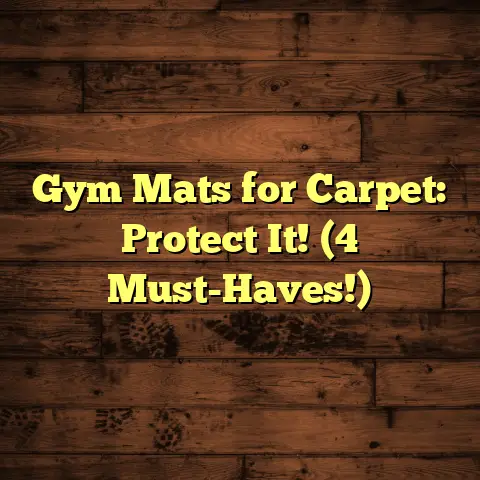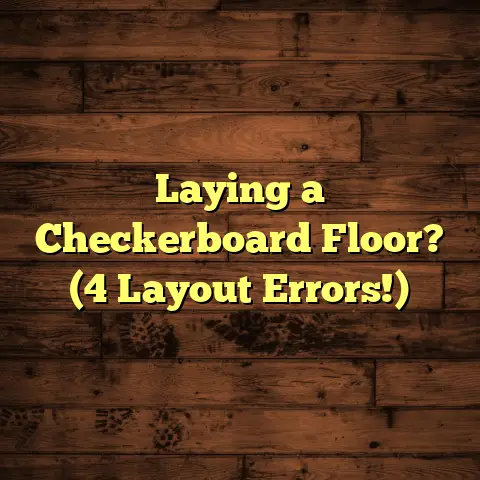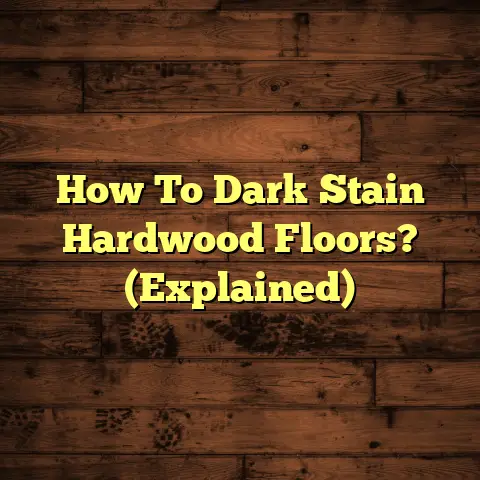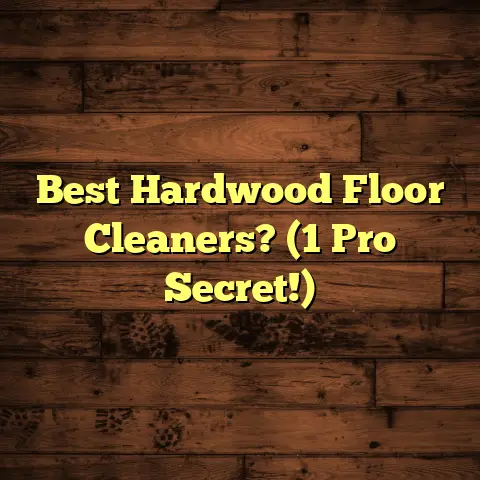Remove Scuffs From Hardwood? (6 Fixes Fast!)
Imagine walking into your home after a long day, and the first thing you notice is the warm glow of your hardwood floors.
They’ve always been a source of pride for you, reflecting your style and the effort you’ve put into maintaining your home.
But today, as you step onto the floor, your gaze falls upon unsightly scuff marks that mar the beauty of the wood.
Each mark tells a story, perhaps from a lively gathering or the day you moved in those heavy furniture pieces.
Now, you’re faced with a dilemma: how do you restore your hardwood floors to their former glory without spending a fortune or damaging the delicate finish?
As a flooring contractor with over 15 years of experience, I’ve seen it all – from minor scuffs to major catastrophes.
And believe me, you’re not alone in this battle against the dreaded scuff mark!
In this article, we will explore six effective and quick fixes to remove scuffs from hardwood floors, ensuring they remain a stunning feature of your home.
Let’s dive in and get those floors looking their best!
Section 1: Understanding Scuff Marks on Hardwood Floors
So, what exactly are scuff marks, and how do they end up on our beautiful hardwood floors?
Simply put, scuff marks are surface blemishes caused by friction.
Think of them as the result of something rubbing against your floor with enough force to leave a visible mark.
These marks aren’t usually deep gouges, but rather a transfer of material from the object that caused the scuff onto the floor’s finish.
Common Culprits Behind Scuff Marks
As a contractor, I’ve seen these scenarios play out time and again:
Furniture Dragging: This is a big one.
Moving chairs, tables, or sofas without proper protection underneath is a surefire way to create scuffs.-
Shoe Soles: Certain shoe materials, especially those with hard rubber or plastic, can leave scuff marks, particularly if you’re walking with a bit of a “heavy foot.”
Pet Activity: Our furry friends can also contribute to the problem.
Their claws, even when trimmed, can sometimes create minor scuffs, especially during playful zoomies.Kids at Play: Let’s face it, kids will be kids.
Toys, bikes, and general roughhousing can all lead to scuff marks.
The Impact of Scuff Marks
Scuff marks aren’t just an aesthetic issue; they can actually affect the longevity of your hardwood floors.
While a few scuffs might seem insignificant, over time, they can accumulate and wear down the floor’s finish.
This makes the wood more vulnerable to moisture, dirt, and other types of damage.
According to the National Wood Flooring Association (NWFA), proper maintenance, including addressing scuff marks promptly, is crucial for extending the life of your hardwood floors.
Section 2: Assessing the Damage
Before you start scrubbing away, it’s important to take a close look at the scuff marks and assess the extent of the damage.
This will help you choose the right approach for removing them.
Surface-Level Scuffs vs. Deeper Scratches
Surface-Level Scuffs: These are usually lighter in color and appear as if something has simply rubbed against the surface.
You might be able to feel a slight texture, but they generally don’t penetrate the finish.Deeper Scratches: These are more noticeable and often reveal the wood underneath the finish.
They can be deeper and wider than scuff marks and may require more intensive repair methods.
To determine the depth, try running your fingernail lightly across the mark.
If it catches, it’s likely a deeper scratch.
Identifying Your Floor’s Finish
Knowing the type of finish on your hardwood floors is crucial before attempting any repairs.
Using the wrong cleaning product or technique can actually damage the finish and make the problem worse.
Here are some common types of hardwood floor finishes:
Oil-Based Polyurethane: This is a durable and water-resistant finish that’s commonly used in homes.
It typically has a slightly amber or yellow tint.-
Water-Based Polyurethane: This finish is more environmentally friendly and dries clear, allowing the natural color of the wood to show through.
Penetrating Oil Finish: This type of finish soaks into the wood rather than forming a hard coating on top.
It gives the floor a natural, matte look.Wax Finish: While less common these days, some older homes may have hardwood floors with a wax finish.
This type of finish requires special care and maintenance.
If you’re unsure about the type of finish on your floors, consult with a flooring professional or refer to your home’s documentation.
Section 3: Quick Fix #1: The Magic of Erasers
Believe it or not, one of the easiest and most effective ways to remove light scuff marks is with a simple eraser!
Yes, the same type of eraser you used in school can work wonders on hardwood floors.
Why Erasers Work
The gentle abrasive nature of erasers helps to lift the scuff marks without damaging the floor’s finish.
I recommend using pink or white vinyl erasers, as they are less likely to leave behind any residue.
Step-by-Step Guide
Clean the Area: Before you start, make sure the area around the scuff mark is clean and free of any loose dirt or debris.
You can use a soft cloth or a vacuum cleaner with a brush attachment.Erase the Scuff: Gently rub the eraser back and forth over the scuff mark, applying light pressure.
Avoid pressing too hard, as this could damage the finish.Check Your Progress: As you erase, periodically check to see if the scuff mark is disappearing.
You may need to repeat the process several times for stubborn marks.-
Clean Up Residue: Once the scuff mark is gone, use a clean, damp cloth to wipe away any eraser residue.
-
Dry the Area: Finally, dry the area with a soft, dry cloth.
Pro Tip
For best results, use a clean eraser.
A dirty eraser could actually transfer more dirt onto your floor.
Section 4: Quick Fix #2: Olive Oil and Vinegar Solution
Here’s a natural and effective solution that you probably already have in your kitchen: olive oil and vinegar!
This combination not only helps to remove scuff marks but also conditions the wood, leaving it looking shiny and healthy.
Why This Works
The mild acidity of vinegar helps to dissolve dirt and grime, while the olive oil lubricates the surface and adds a protective layer.
Recipe and Application
-
Mix the Solution: In a clean spray bottle, combine 1/2 cup of olive oil and 1/2 cup of white vinegar.
-
Shake Well: Shake the bottle vigorously to ensure the ingredients are thoroughly mixed.
-
Test in an Inconspicuous Area: Before applying the solution to the entire floor, test it in a small, hidden area to make sure it doesn’t damage the finish.
-
Spray Lightly: Lightly spray the solution onto the affected area.
-
Wipe with a Soft Cloth: Use a clean, soft cloth to wipe the area in a circular motion.
-
Buff to Shine: Once the scuff mark is gone, buff the area with a dry, clean cloth to restore the shine.
Dual Benefit
Not only does this solution remove scuffs, but it also helps to condition the wood, preventing it from drying out and cracking.
Section 5: Quick Fix #3: Baking Soda Paste
Baking soda is another household staple that can be used to remove scuff marks from hardwood floors.
Its mild abrasive properties make it effective at lifting stubborn marks without damaging the finish.
Making the Paste
Mix the Ingredients: In a small bowl, mix together baking soda and water to form a thick paste.
The consistency should be similar to toothpaste.-
Apply the Paste: Using a soft cloth or your fingertip, gently apply the paste to the scuff mark.
Rub Gently: Rub the paste in a circular motion, applying light pressure.
Be careful not to scratch the wood.-
Wipe Clean: After a few minutes, wipe away the paste with a damp cloth.
-
Dry the Area: Dry the area thoroughly with a clean, dry cloth.
Precautions
-
Always test the paste in an inconspicuous area first to ensure it doesn’t damage the finish.
-
Avoid using too much pressure when rubbing, as this could scratch the wood.
Section 6: Quick Fix #4: Commercial Floor Cleaners
When it comes to cleaning and maintaining hardwood floors, there are countless commercial products available.
However, it’s important to choose the right product for your specific type of floor and finish.
Choosing the Right Product
-
Read the Labels: Always read the product label carefully to ensure it’s compatible with your floor’s finish.
-
Look for pH-Neutral Cleaners: pH-neutral cleaners are generally safe for hardwood floors, as they won’t damage the finish.
-
Avoid Harsh Chemicals: Avoid using cleaners that contain harsh chemicals, such as ammonia or bleach, as these can strip the finish and damage the wood.
Application Tips
-
Follow the Instructions: Always follow the manufacturer’s instructions when applying commercial floor cleaners.
-
Use a Microfiber Mop: Use a microfiber mop or cloth to apply the cleaner evenly.
-
Avoid Over-Wetting: Avoid over-wetting the floor, as this can cause water damage.
-
Dry Thoroughly: Dry the floor thoroughly with a clean, dry cloth after cleaning.
My Go-To Products
Over the years, I’ve found that products from Bona and Murphy’s Oil Soap tend to work well for most hardwood floors.
However, it’s always a good idea to test the product in an inconspicuous area first.
Section 7: Quick Fix #5: Using a Soft Cloth and Water
Sometimes, the simplest solutions are the most effective.
For minor scuff marks, a damp cloth and a little elbow grease may be all you need.
The Power of Simplicity
The gentle friction of a soft cloth can help to lift the scuff mark without damaging the finish.
Step-by-Step Instructions
Dampen the Cloth: Dampen a soft, clean cloth with water.
Make sure the cloth is not too wet, as excess water can damage the floor.-
Rub the Scuff: Gently rub the scuff mark with the damp cloth in a circular motion.
-
Apply Pressure: Apply light pressure as you rub, but be careful not to scratch the wood.
-
Dry the Area: Once the scuff mark is gone, dry the area with a clean, dry cloth.
Preventing Water Damage
-
Always use a damp cloth, not a wet one.
-
Dry the area thoroughly after cleaning.
Section 8: Quick Fix #6: Touch-Up Markers
For deeper scuff marks or scratches that penetrate the finish, touch-up markers can be a lifesaver.
These markers are specifically designed to match the color of your hardwood floors and conceal imperfections.
Choosing the Right Marker
Match the Color: Choose a touch-up marker that closely matches the color of your floor.
You may need to test several markers to find the perfect match.-
Consider the Finish: Some markers are designed for specific types of finishes, such as oil-based or water-based.
Application Tips
-
Clean the Area: Clean the area around the scuff mark with a damp cloth.
-
Apply the Marker: Carefully apply the marker to the scuff mark, following the grain of the wood.
-
Blend the Color: Use a soft cloth or your fingertip to blend the color and remove any excess marker.
-
Let it Dry: Allow the marker to dry completely before walking on the area.
-
Seal the Area: For added durability, you can seal the area with a clear finish.
My Favorite Brands
I’ve had good results with touch-up markers from Minwax and Mohawk.
Section 9: Preventing Future Scuffs
Prevention is always better than cure.
Here are some practical tips to help you prevent scuff marks from occurring in the first place:
Furniture Pads
- Attach felt pads to the bottom of all furniture legs.
This will prevent the furniture from scratching the floor when it’s moved.
Area Rugs
- Place area rugs in high-traffic areas, such as hallways and living rooms.
This will protect the floor from wear and tear.
Proper Cleaning Techniques
-
Sweep or vacuum your hardwood floors regularly to remove dirt and debris.
-
Use a damp mop with a pH-neutral cleaner to clean the floors.
-
Avoid using harsh chemicals or abrasive cleaners.
Regular Maintenance
-
Reapply a coat of polyurethane every few years to protect the finish.
-
Consider professional floor cleaning and polishing to restore the shine.
The Cost of Prevention
While these preventative measures may seem like an added expense, they can actually save you money in the long run by extending the life of your hardwood floors.
According to a study by the National Association of Realtors, homes with well-maintained hardwood floors tend to sell for a higher price.
Conclusion: Restoring the Beauty of Your Hardwood Floors
So, there you have it – six quick and effective fixes for removing scuff marks from your hardwood floors!
From the magic of erasers to the power of natural solutions, there’s a method for every type of scuff mark.
Remember, assessing the damage and identifying your floor’s finish are crucial steps before attempting any repairs.
And don’t forget the importance of prevention!
By taking simple steps to protect your floors, you can keep them looking beautiful for years to come.
With a little effort and the right techniques, you can maintain the beauty of your hardwood flooring and enjoy the warm glow of your home for years to come.
Now go forth and conquer those scuff marks!
Your floors (and your feet) will thank you.





